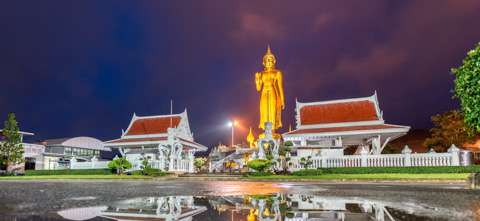How much does it cost to travel to Hat Yai?
You should plan to spend around $16 (฿590) per day on your vacation in Hat Yai. This is the average daily price based on the expenses of other visitors.
Past travelers have spent, on average for one day:
- $10 (฿371) on meals
- $0.63 (฿23) on local transportation
- $10 (฿375) on hotels
A one week trip to Hat Yai for two people costs, on average, $227 (฿8,265). This includes accommodation, food, local transportation, and sightseeing.
All of these average travel prices have been collected from other travelers to help you plan your own travel budget.
Independent Travel
Traveling Independently to Hat Yai has many benefits including affordabilty, freedom, flexibility, and the opportunity to control your own experiences.
All of the travel costs below are based on the experiences of other independent travelers.
Is Hat Yai expensive to visit?
Hat Yai is a very affordable place to visit. Located in Thailand, which is a reasonably affordable country, visitors will appreciate the lower prices of this destination. It is in the top 10% of cities in the country for its affordability. Budget travelers enjoy spending long periods of time exploring Hat Yai in depth.
Within Asia, Hat Yai is a very affordable destination compared to other places. It is in the top 10% of cities in Asia for its affordability. Very few cities in the region are as affordable as Hat Yai.
For more details, and to find out if it's within your travel budget, see Is Hat Yai Expensive?
How much money do I need for a trip to Hat Yai?
The average Hat Yai trip cost is broken down by category here for independent travelers. All of these Hat Yai travel prices are calculated from the budgets of real travelers.
|
Category
|
Cost
|
|
Accommodation 1
(Double Occupancy)
|
฿375
($10)
|
|
Local Transportation 1
|
฿23
($1)
|
|
Food 2
|
฿371
($10)
|
|
Alcohol 2
|
฿46 -
139
($1 - 4)
|
Accommodation Budget in Hat Yai
Calculated from travelers like you
The average price paid for one person for accommodation in Hat Yai is $5.14 (฿188). For two people sharing a typical double-occupancy hotel room, the average price paid for a hotel room in Hat Yai is $10 (฿375). This cost is from the reported spending of actual travelers.
Looking for a hotel in Hat Yai? Prices vary by location, date, season, and the level of luxury. See below for options.
Transportation Budget in Hat Yai
Calculated from travelers like you
-
The cost of a taxi ride in Hat Yai is significantly more than public transportation. On average, past travelers have spent $0.63 (฿23) per person, per day, on local transportation in Hat Yai.
-
Transportation1
Taxis, local buses, subway, etc.
$0.63
฿23
How much does it cost to go to Hat Yai? Naturally, it depends on the dates. We recommend Kayak because they can find the best deals across all airlines.
The price of renting a car in Hat Yai will depends on dates, the type of car, the location, and your age. We recommend Kayak because they can find the best deals across all car rental companies.
Food Budget in Hat Yai
Calculated from travelers like you
-
While meal prices in Hat Yai can vary, the average cost of food in Hat Yai is $10 (฿371) per day. Based on the spending habits of previous travelers, when dining out an average meal in Hat Yai should cost around $4.07 (฿148) per person. Breakfast prices are usually a little cheaper than lunch or dinner. The price of food in sit-down restaurants in Hat Yai is often higher than fast food prices or street food prices.
-
Food2
Meals for one day
$10
฿371
Typical prices for Food in Hat Yai are listed below. These actual costs are from real travelers and can give you an idea of the prices in Hat Yai, but your costs will vary based on your travel style and the place where the purchase was made.
Alcohol Budget in Hat Yai
Calculated from travelers like you
-
The average person spends about $2.54 (฿93) on alcoholic beverages in Hat Yai per day. The more you spend on alcohol, the more fun you might be having despite your higher budget.
-
Alcohol2
Drinks for one day
$2.54
฿93
Typical prices for Alcohol in Hat Yai are listed below. These actual costs are from real travelers and can give you an idea of the prices in Hat Yai, but your costs will vary based on your travel style and the place where the purchase was made.
Water Budget in Hat Yai
Calculated from travelers like you
-
On average, people spend $0.52 (฿19) on bottled water in Hat Yai per day. The public water in Hat Yai is considered safe to drink.
-
Water2
Bottled water for one day
$0.52
฿19
Hat Yai on a Budget
 Hat Yai, Thailand
Hat Yai, Thailand
The fourth largest city of Thailand, Hat Yai is a popular tourist destination, especially on weekends and holidays for people in neighboring Malaysia and Singapore. It is best known as a commercial hub and shopping destination, and for its floating market and Buddhist temple.
Sights
While most people visit Hat Yai to immerse themselves in the shopping, there are several sights worth seeing. On the northern outskirts of the city, Hat Yai Municipal Park has a number of attractions. A cable car runs to the top of a hill where the golden Phra Buddha Mongkol Maharaj statue is located and the Bodhisattva Kuan Im (Guan Yin) Temple. The park is also home to the Hat Yai Observatory, which allows visitors to explore science and astronomy.
As far as statues go, the most famous is probably the reclining Buddha (Phra Phuttha Hattha Mongkhon) at Wat Hat Yai Nai. Measuring about 35 meters long, 15 meters tall, and 10 meters wide, it is thought to be the third largest reclining Buddha in the world and is well-regarded by locals and tourists alike. It is located near the Khlong U Taphao Bridge.
For those interested in escaping the city for a day, travel about 29 kilometers southwest out to Ton Nga Chang Wildlife Sanctuary. Here visitors come to admire the Ton Nga Chang Waterfall, which has seven levels of flowing waters. The third level is the most beautiful, separating into two streams. The general area is popular for swimming and recreation.
Neighborhoods
Due to its shopping reputation, the downtown of Hat Yai is mostly developed into shopping and entertainment venues. For a more unique experience different from typical shopping malls and department stores, head to the Klong Hae floating market and do some shopping there. Hat Yai has additional markets sprinkled throughout its streets, some of which really come to life at night with lights and colors. No matter where you turn, if you are wandering the streets of central Hat Yai, there will be plenty to see, do, eat, and experience at every corner.
Activities
Hat Yai is also host to a few seasonal events and festivals. The Hat Yai Ice Dome, for example, near Hat Yai Park is a venue for a display of ice sculptures by sculptors from Harbin, China. Another annual event in the park is Hat Yai Lantern, held alongside the park's lake at the beginning of each year. Because of the city's large Thai Chinese population, the Chinese New Year is also well-celebrated, especially in the city center. Other significant festivals include the Songkran Festival held in April in honor of the Thai New Year, as well as Loi Krathong held in November when people pay their respects to the goddess of water with beautiful floating candles and lanterns.
Food and Dining
Being a large city, Hat Yai is host to a large amount of different food options. While there are international chains offering Japanese and Western food for the less adventurous palette, Thai street food is abundant and a must for experiencing the local flavors. Here are some of the favorites:
Thai Boat Noodle (Doy Kuay Teow Reua): small bowl with slices of pork, a pork ball, bean sprouts, kang kong (water spinach), and garnished with spring onions and coriander, can be served dry or in soup.
Pad Thai Noodles: national dish of Thailand, includes freshly fried noodles, tamarind, garlic, chili, peanuts and sometimes vegetables.
Thai Grilled Pork Skewers (Moo Ping): seasoned with garlic, soy sauce, and sugar.
Thai Grilled Chicken (Gai Yang): Thailand's version of street BBQ
Pad Kra Pao: minced pork or chicken stir-fried with Thai basil and chilies and served over white rice
Pad See Ew: warm and comforting dish of wide flat noodles stir-fried in a dark soy-sauce with chicken, pork, or beef, and some vegetables.
Mango Sticky Rice (Khao Neeo Mamuang): served with a coconut milk syrup.
These are just a few examples of the many tasty Thai dishes to try in Hat Yai.
Transportation
The main point of entry by plane is Hat Yai International Airport, located about 25 minutes southeast of central Hat Yai by car. From the airport, travelers can take a taxi, limo, van, car rental, or a songthaew, which is the cheapest option. Songthaew are basically pickup trucks that have been converted with benches for passengers and are operated as local buses and sometimes taxis.
Hat Yai is also connected by train to several locations including Bangkok, Sungai Kolok, Surat Thani, and Malaysia. Additionally long distance buses are available to and from major cities in the area.
We've been gathering travel costs from tens of thousands of actual travelers since 2010, and we use the data to calculate average daily travel costs for destinations around the world. We also systematically analyze the prices of hotels, hostels, and tours from travel providers such as Kayak, HostelWorld, TourRadar, Viator, and others. This combination of expenses from actual travelers, combined with pricing data from major travel companies, gives us a uniqe insight into the overall cost of travel for thousands of cities in countries around the world. You can see more here: How it Works.
 Hat Yai, Thailand
Hat Yai, Thailand

 Budget Your Trip is all about finding out how much everything costs so that you can travel cheaper and longer. Created by avid travelers Laurie and Bryan, our goal is to help you plan your next trip on the right budget. With average daily travel costs that are calculated from the budgets of real travelers, plus an analysis of hotel and tour prices, you can find out how much money you need to plan your next adventure. We also have plenty of travel advice, accommodation reviews, and activity suggestions.
Budget Your Trip is all about finding out how much everything costs so that you can travel cheaper and longer. Created by avid travelers Laurie and Bryan, our goal is to help you plan your next trip on the right budget. With average daily travel costs that are calculated from the budgets of real travelers, plus an analysis of hotel and tour prices, you can find out how much money you need to plan your next adventure. We also have plenty of travel advice, accommodation reviews, and activity suggestions.
I love that everything is cheap here because it's not one of the more touristy places in Thailand. We went to the park and rode the cable car up to the top of the peak and it was very cheap. We also did a tour to the waterfalls and it was also pretty cheap. The markets are fun and free, too.